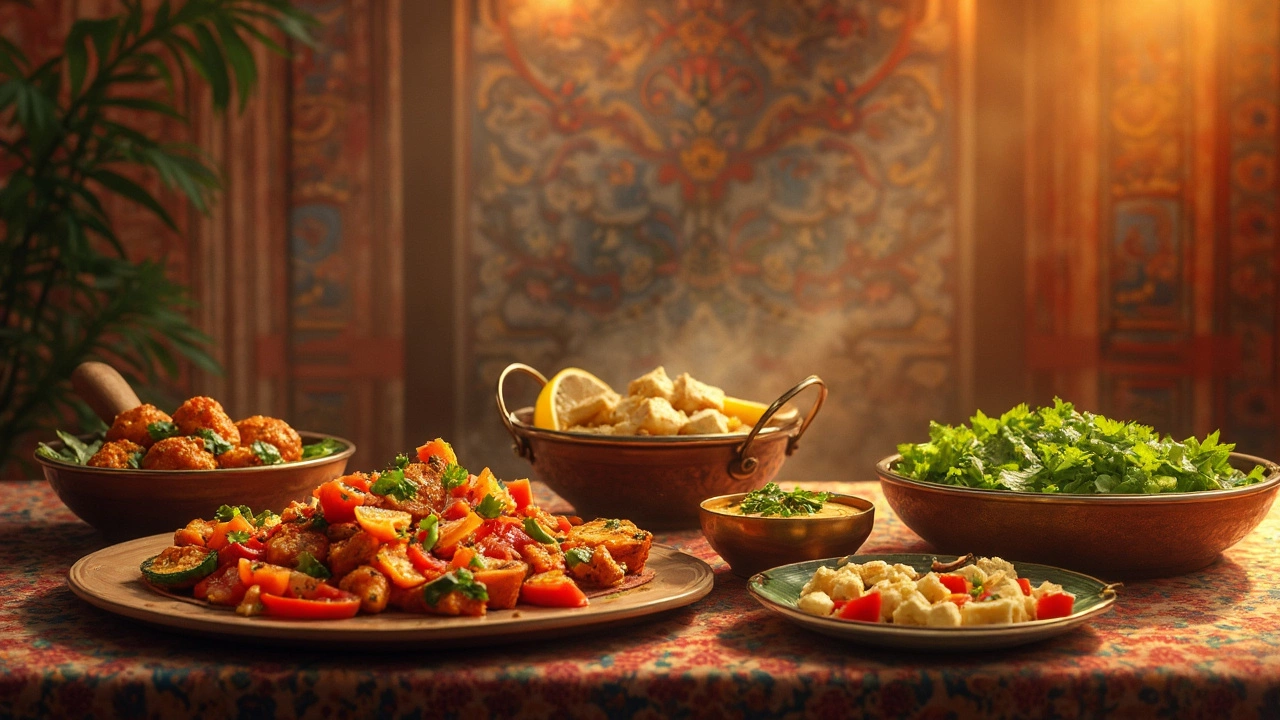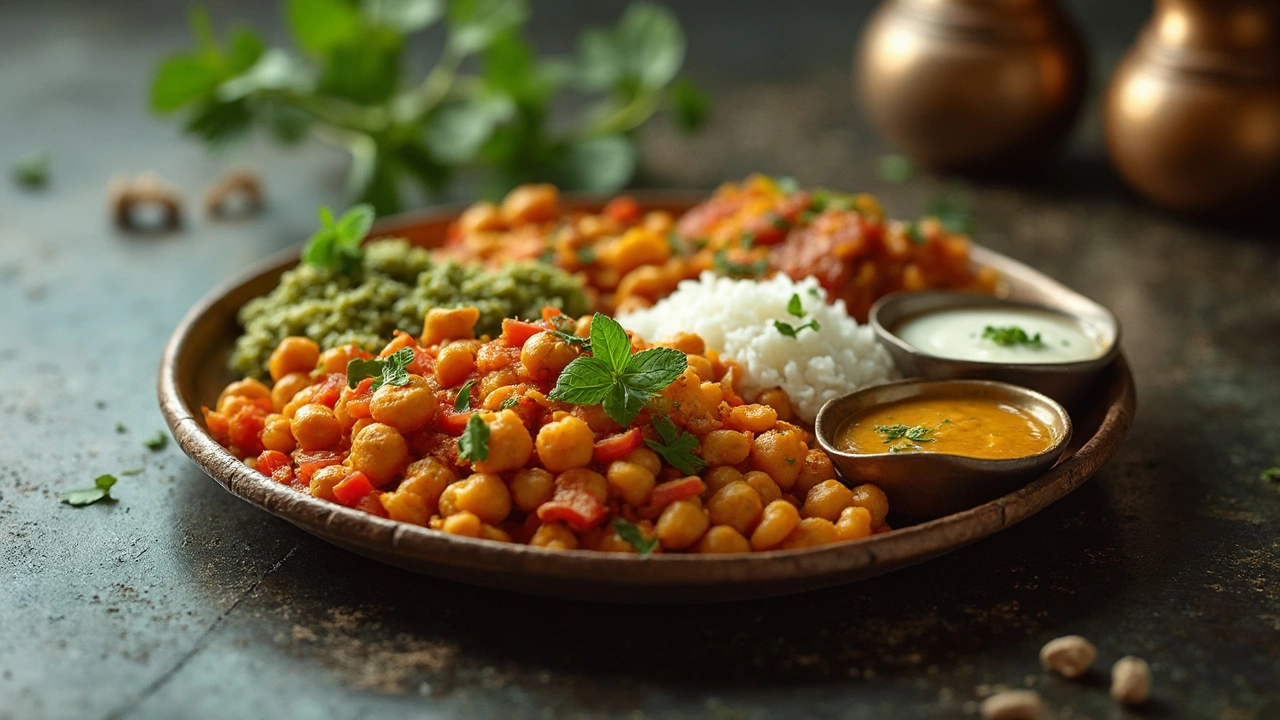Healthiest Choices at an Indian Restaurant: What to Eat?

Ever found yourself puzzled staring at an Indian restaurant menu, trying to figure out what's healthy without compromising on taste? You're not alone! Indian cuisine is packed with flavors, but it can be a bit tricky to navigate when you're trying to eat healthily.
Let's start by understanding the complexity of Indian cuisine. Rich spices and diverse dishes make it a feast for the senses. But if you're aiming for a balanced meal, there are some key pointers to keep in mind. Think more about the ingredients and less about the preparation method.
A simple trick? Opt for dishes heavy on veggies and light on cream. Spinach-based 'Saag' dishes or 'Baingan Bharta', a roasted eggplant dish, are not only flavorful but also packed with nutrients.
- Understanding Indian Cuisine
- Must-Try Healthy Dishes
- Ingredients that Pack a Punch
- Tips for Ordering Smart
- Balancing Flavors and Nutrition
Understanding Indian Cuisine
When it comes to Indian cuisine, the first thing that comes to mind is a burst of flavors, thanks to the rich spices and diverse ingredients used. Whether you're a curry lover or a fan of tandoori dishes, there's no shortage of variety.
One thing to know about Indian cuisine is its regional diversity. The dishes and flavors you experience in the north can be completely different from those in the south. Northern Indian food tends to be richer, with ghee and cream-based dishes like butter chicken or paneer tikka. On the flip side, southern Indian cuisine often features coconut and tamarind, seen in dishes like masala dosa and sambar.
Common Ingredients
Spices are at the heart of Indian cooking. From turmeric's golden glow to cumin's earthy flavor, these spices are not just for taste—many have health benefits too! Turmeric, for example, is known for its anti-inflammatory properties.
- Lentils: Often used in dal, a staple in many households, lentils are a great source of protein and fiber.
- Chickpeas: Found in chana masala, they're protein-packed and rich in iron.
- Rice: Basmati rice is common, offering a light and fluffy complement to many dishes.
Diets and Indian Food
Indian food is quite accommodating to various dietary preferences. Vegetarians will find plenty of options, given the popularity of plant-based meals. For those avoiding gluten, many dishes are naturally gluten-free, relying on rice or lentils instead.
Understanding these basics will not only help you navigate an Indian restaurant menu but also make smarter, healthier choices. Whether it's appreciating the artistry in its preparation or embracing the use of spices, Indian cuisine truly offers a wholesome dining experience.
Must-Try Healthy Dishes
If you're stepping into an Indian restaurant and want to keep things both tasty and health-conscious, you've got some stellar options. Let’s chat about a few healthy picks that pack loads of flavor without the guilt.
Chana Masala
This is a chickpea dish that's a superstar for anyone looking out for their health. Rich in protein and fiber, Chana Masala keeps you full for longer and is a fantastic choice if you're trying to cut down on meat. Pair it with a side of brown rice or whole wheat roti for a balanced meal.
Tandoori Chicken
Craving some meat? Tandoori chicken is a delicious option for those who love that grilled taste. Cooked in a tandoor, this dish is lean on calories and high in protein. Because it's marinated in yogurt and spices, you get all the flavor with less fat compared to fried chicken dishes.
Dal Tadka
One can't talk about healthy Indian food without mentioning dal. Dal Tadka is a hearty lentil dish that's high in protein and low in fat. Lentils are a fantastic source of plant-based protein, and they're super filling too.
Raita
Want something to cool down a spicy meal? Raita to the rescue. This yogurt-based side dish is excellent for digestion and offers a cooling effect to your spicy flavors. It's light and refreshing, making it a perfect companion for most dishes.
Mixed Vegetable Curry
Mix it up with a medley of veggies! A Mixed Vegetable Curry is great for getting a wide range of nutrients. Depending on what's in season, it could have anything from carrots and beans to bell peppers and peas.
With these dishes, eating out at an Indian restaurant can be both fun and nutritious. Remember, the key is to balance your plate with veggies and lean proteins, keeping the fats and carbs in check.

Ingredients that Pack a Punch
One of the reasons people love Indian cuisine is the incredible variety of spices—these aren’t just about flavor but also come with health benefits. Let's dig into a few key ingredients that make Indian dishes not only delicious but also nutritious.
Turmeric
You may have heard that turmeric is all the rage due to its main active ingredient, curcumin. It has anti-inflammatory properties and can aid digestion. So, when you spot a dish with a golden hue, it's likely to have this wonder spice.
Ginger
Used in both fresh and dried forms, ginger adds a zing to the dish while also being great for digestion. It’s a staple in many Indian sauces and curries.
Garlic
Garlic isn't just a flavor booster—it's packed with antioxidants and can help with immunity. Garlic chutneys or the garlic-heavy 'Lahsun ki chutney' are two examples where this ingredient shines.
Fenugreek
Often used in seed or leaf form, fenugreek is great for metabolism and has been shown to help manage blood sugar levels. Look for it in dishes like 'Methi Paratha' or 'Aloo Methi.'
Legumes
Important to most vegetarian diets, lentils and chickpeas are a core part of Indian cuisine. They're loaded with protein and fiber, keeping you full and satisfied. Dishes like 'Dal Tadka' and 'Chana Masala' are filling choices you can count on.
| Ingredient | Key Benefit |
|---|---|
| Turmeric | Anti-inflammatory |
| Ginger | Digestive aid |
| Garlic | Boosts immunity |
| Fenugreek | Regulates blood sugar |
| Legumes | High in protein |
Next time you're at an Indian restaurant, keep an eye out for these ingredients. Not only will they make your meal tastier, but they'll also leave you feeling healthier!
Tips for Ordering Smart
Walking into an Indian restaurant can be a sensory overload with all its vibrant dishes and aromatic spices. Don't get sidetracked by the smells—stay focused on your health goals!
Keep It Simple, Keep It Healthy
When in doubt, choose dishes that are grilled or baked. Think 'tandoori' options over fried ones. Tandoori chicken, for example, is flavored with bold spices and cooked in a tandoor (a clay oven), offering a low-fat alternative to fried dishes.
Go Heavy on Veggies
You can't go wrong with the myriad vegetarian options like 'Chana Masala' (chickpeas in spicy tomato sauce) or 'Aloo Gobi' (potato and cauliflower curry). These are typically made with minimal cream and pack a nutrient punch.
Watch the Breads
While naan can be deliciously tempting, it's also heavy with refined flour. Ask if the restaurant offers whole wheat options like 'Roti' or 'Chapati'. They’re much lighter and just as tasty!
Mind the Sides
Some side dishes can be calorie traps. Be cautious with dishes like 'Raita' made with creamy yogurt or 'Papadums', which are fried. Choose steamed rice over fried rice and add a side salad if possible.
Drink Smart
Skip the sugary sodas and opt for traditional Indian drinks like Masala Chai without sugar, or a simply refreshing glass of water with a slice of lemon.
| Dish | Calories (Approx) |
|---|---|
| Tandoori Chicken | 260 |
| Chana Masala | 180 |
| Roti | 90 |
So, next time you're at your favorite Indian spot, remember these tips. You'll be enjoying your meal without any guilt, sticking to healthy Indian food choices without compromising on flavor!

Balancing Flavors and Nutrition
Eating Indian doesn't mean you have to sacrifice nutrition for taste. The trick is to balance both flavors and health in one plate. So, how do you manage this when you're at an Indian restaurant? Let's break it down!
Choose the Right Dishes
Focus on dishes that are rich in vegetables and lean proteins. You can go for tandoori options like chicken or fish, which are marinated in spices and grilled, making them lower in fat compared to fried options. Dishes like 'Daal', a lentil-based dish, offer great sources of protein and fiber.
Watch the Sides and Breads
While naan bread is delicious, it's often packed with calories. Instead, choose roti or chapati, which are whole-wheat options with more fiber. Balance is everything, so if you're loading up on rice or bread, keep the portions in check.
Spice and Health
Indian dishes are rich in spices like turmeric, known for its anti-inflammatory properties, and cumin, which aids digestion. These aren't just for taste; they bring significant health benefits. Don't be afraid to enjoy a bit of spice.
Keep an Eye on the Cream
Dishes like 'butter chicken' can be heavy on the cream, adding to the calorie count. Instead, look for tomato-based curries or those with coconut milk, which might be lighter yet still delicious.
Here's a quick table to remember:
| Dish Preference | Healthier Alternative |
|---|---|
| Butter Chicken | Chicken Tikka |
| Naan | Roti |
| Samosa | Grilled Paneer |
By focusing on these easy swaps and being mindful during your meal, you can savor all the flavors Indian cuisine offers without losing sight of your health goals. Remember, it's all about making those healthy choices at your favorite Indian spot!